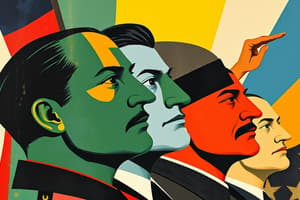Podcast
Questions and Answers
What is the primary characteristic of fascism?
What is the primary characteristic of fascism?
- Dictatorial power and extreme nationalism (correct)
- Proletarian internationalism
- Collective ownership of production
- Classless society
Which of the following was a notable method of control utilized in Hitler's Germany?
Which of the following was a notable method of control utilized in Hitler's Germany?
- Promoting a classless society
- Propaganda through media and rallies (correct)
- State ownership of all agricultural production
- Collective decision making in government
What economic system is most associated with communism?
What economic system is most associated with communism?
- Free market capitalism
- Corporate ownership
- State control through planning (correct)
- Feudalism
Which of the following accurately describes a characteristic of Stalin's USSR?
Which of the following accurately describes a characteristic of Stalin's USSR?
What was one of the primary goals of fascist regimes in the 20th century?
What was one of the primary goals of fascist regimes in the 20th century?
What did the Great Purge in Stalin's USSR primarily aim to achieve?
What did the Great Purge in Stalin's USSR primarily aim to achieve?
How did Hitler's regime view other political ideologies?
How did Hitler's regime view other political ideologies?
What was a notable feature of Mussolini's fascist regime?
What was a notable feature of Mussolini's fascist regime?
Flashcards are hidden until you start studying
Study Notes
Totalitarianism of the 20th Century
Fascism
- Definition: Authoritarian political system characterized by dictatorial power, extreme nationalism, and suppression of opposition.
- Key Features:
- Centralized control of the state.
- State propaganda to promote national unity.
- Emphasis on militarism and expansionism.
- Anti-communism and anti-liberalism.
- Notable Examples:
- Benito Mussolini’s Italy: Established the first fascist regime (1922).
- Integration of state and corporate power.
- Cult of personality around leaders.
Communism
- Definition: Political and economic ideology advocating for a classless society and collective ownership of the means of production.
- Key Features:
- Centralized control of the economy through state planning.
- Suppression of political dissent and opposition.
- Emphasis on revolutionary change and proletarian internationalism.
- Notable Examples:
- Soviet Union under Lenin and later Stalin.
- Use of secret police and purges to eliminate threats.
- Propaganda to promote Marxist-Leninist ideology.
Hitler's Germany
- Overview: Totalitarian regime established by Adolf Hitler and the National Socialist German Workers' Party (Nazi Party).
- Key Features:
- Strong emphasis on Aryan nationalism and racial purity.
- Expansionist policies leading to World War II.
- Systematic persecution of Jews, political opponents, and minorities (Holocaust).
- State control over all aspects of life, including education and culture.
- Methods of Control:
- Use of propaganda through media and rallies.
- Establishment of a police state (Gestapo).
- Cult of personality around Hitler.
Stalin's USSR
- Overview: Authoritarian regime under Joseph Stalin, marked by rapid industrialization and collectivization.
- Key Features:
- State ownership of agriculture and industry.
- Use of terror and purges to maintain control (Great Purge).
- Suppression of dissent through censorship and imprisonment.
- Emphasis on socialist realism in arts and culture.
- Key Policies:
- Five-Year Plans aimed at economic growth.
- Gulags for political prisoners and dissenters.
- Propaganda promoting Stalin’s image as a leader and savior.
Fascism
- Authoritarian political system with dictatorial power and extreme nationalism, suppressing opposition.
- Features centralized state control, state propaganda for national unity, and militarism alongside expansionist aims.
- Positioned against communism and liberal ideologies, fostering a hostile environment for dissenters.
- Notable example includes Benito Mussolini’s Italy, which created the first fascist regime in 1922, merging state and corporate powers while cultivating a cult of personality for leaders.
Communism
- Political and economic ideology aimed at achieving a classless society through collective ownership of production means.
- Centralized economic control through state planning presents a significant hallmark, alongside an authoritarian suppression of dissent.
- Focuses on revolutionary transformation and international solidarity among the proletarian class.
- Exemplified by the Soviet Union under Lenin and Stalin, utilizing secret police and purges to eliminate threats while promoting Marxist-Leninist propaganda.
Hitler's Germany
- Totalitarian regime led by Adolf Hitler and the Nazi Party, characterized by Aryan nationalism and the pursuit of racial purity.
- Expansionist policies played a critical role in instigating World War II, coupled with the systematic persecution of Jews and other minorities in the Holocaust.
- State influence permeated education, culture, and all life facets, emphasizing propaganda via the media and large rallies to maintain control.
- Gestapo's establishment supported a police state, fostering a cult of personality around Hitler.
Stalin's USSR
- Authoritarian regime under Joseph Stalin, distinguished by rapid industrialization and agricultural collectivization.
- State ownership is predominant in both agriculture and industry, with terror and purges (Great Purge) employed for control.
- Censorship and imprisonment are key methods for suppressing dissent, while socialist realism emphasizes governance in arts and culture.
- Implemented Five-Year Plans aimed at fostering economic growth, supported by gulags for political prisoners and propaganda enhancing Stalin’s image as a leader and savior.
Studying That Suits You
Use AI to generate personalized quizzes and flashcards to suit your learning preferences.




